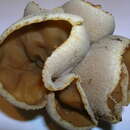pt-BR
nomes no trilho de navegação


Peziza cerea, commonly known as the Cellar Cup is a species of ascomycete fungus in the genus Peziza, family Pezizaceae. In common with other ascomycetes the upper surface of the fungus has a layer of cylindrical spore producing cells called asci, from which the ascospores are forcibly discharged.
A yellow grey to beige fungus internally, less than 5 cm across with a granular or brittle flesh. The stype is placed in a lateral position, but is small or even entirely absent. The spore colour is white, cream or yellowish; they are elliptical and smooth. The cup exterior is white in colour.[2]
Peziza cerea can be initially identified by its growth in cellars, damp mortar, soil between pavement slabs, on rotting sandbags, plant material or manure. Found all year round. Its upper surface (at maturity) is usually somewhat wrinkled near the centre; a whitish and minutely fuzzy under surface; a round, cuplike shape when young, and a flattened-irregular shape when mature. The hymenium contains asci, ascospores and paraphyses. Paraphyses are sterile cells' often with swollen tips and are at high turgor pressure. Tips of the paraphyses are very tightly together at the surface of the hymenium and create a barrier; the epithecium.
A high osmotic pressure in the cells of the epithecium prevent marauding microfauna that would otherwise penetrate and feed on the rich protoplasm below. To disperse spores, asci push between the paraphyses from below, shoot off their spores then collapse.[3]
The name Peziza means a sort of mushroom without a root or stalk.
Paths and cellars may sport the Cellar Cup fungus, which is saprobic.
P. cerea is inedible.[4]
P. cerea is widely distributed throughout America and Europe[4]
Peziza cerea, commonly known as the Cellar Cup is a species of ascomycete fungus in the genus Peziza, family Pezizaceae. In common with other ascomycetes the upper surface of the fungus has a layer of cylindrical spore producing cells called asci, from which the ascospores are forcibly discharged.
Kahvatu liudik (Peziza cerea) on kottseente hulka kuuluv seeneliik.
Seent on leitud ka Eestist.
Seen on mittesöödav.[1]
Kahvatu liudik (Peziza cerea) on kottseente hulka kuuluv seeneliik.
Seent on leitud ka Eestist.
Seen on mittesöödav.
Cost artìcol a l'é mach në sbòss. Da finì.
A chërs an dzora ai tochet ëd bòsch, an sël teren dle sère o an col sabios.
![]() A venta mai mangé un bolè trovà se un a l'é nen un bon conossidor dij bolè!
A venta mai mangé un bolè trovà se un a l'é nen un bon conossidor dij bolè!
Sensa antëresse alimentar.
Cost artìcol a l'é mach në sbòss. Da finì.
AmbientA chërs an dzora ai tochet ëd bòsch, an sël teren dle sère o an col sabios.
Comestibilità![]() A venta mai mangé un bolè trovà se un a l'é nen un bon conossidor dij bolè!
A venta mai mangé un bolè trovà se un a l'é nen un bon conossidor dij bolè!
Sensa antëresse alimentar.
Peziza cerea je grzib[7], co go ôpisoł Sowerby 1796. Peziza cerea nŏleży do zorty Peziza i familije Pezizaceae.[8][9] Żŏdne podgatōnki niy sōm wymianowane we Catalogue of Life.[8]
Peziza cerea je grzib, co go ôpisoł Sowerby 1796. Peziza cerea nŏleży do zorty Peziza i familije Pezizaceae. Żŏdne podgatōnki niy sōm wymianowane we Catalogue of Life.